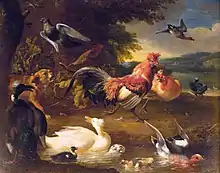Brabanter
The Brabanter is a Dutch breed of crested chicken originating in the historic region of Brabant which straddles Belgium and the Netherlands. It is an ancient breed and is shown in 17th-century paintings.[3] A bantam Brabanter was created in around 1934.[4]
 A painting by Melchior d'Hondecoeter, apparently showing a Brabanter cock and hen | |
| Conservation status | Netherlands |
|---|---|
| Other names | Brabançonne |
| Country of origin | Netherlands |
| Traits | |
| Weight | |
| Comb type | V-shaped |
| Classification | |
| PCGB | rare soft feather: light[2] |
| |
History
The Brabanter has been bred in the Netherlands, and particularly in Brabant, for a long time. The oldest known image of one is in a painting of 1676 by the Dutch artist Melchior d'Hondecoeter. They soon spread from their area of origin. Black and Cuckoo Brabanters were shown at the first German poultry exhibition, at Görlitz in Saxony, in 1854.[5] The Brabanter became nearly extinct in the early 20th century, but was recovered by cross-breeding with other crested and bearded birds.[6]
Characteristics
The Brabanter is among the lightest of chicken breeds; cocks weigh 1.9–2.5 kg and hens 1.6–2.0 kg.[5] It has a narrow crest and a three-part beard. The crest is unlike that of most other crested breeds such as the Polish: it projects upwards and slightly forwards like that of the very similar Swiss Appenzeller Spitzhauben. The Brabanter has a V-shaped comb. The earlobes are small and white, and the wattles are often absent;[1] both earlobes and wattles are hidden by the beard.[5][6]
Seven colour varieties are recognised in the Netherlands: black, chamois, cuckoo, gold spangled, laced blue, silver spangled and white;[4] in Germany there are thirteen.[7]
A bantam Brabanter was created in around 1934 by cross-breeding the standard-sized Brabanter with bearded bantams of the Polish breed.[4]
Use
Hens lay a moderate number of white eggs, do not frequently go broody, and are fairly good winter layers. The breed has a fair build, and thus is a decent table-bird. The Brabanter is a calm breed that is intelligent. It can stand confinement. The Brabanter is suitable for cold areas because its smaller comb and wattles are less susceptible to frostbite.
See also
References
- The Brabante. BKU-Club (Speciaalclub van liefhebbers en fokkers van Brabanters, Kraaikoppen en Nederlandse Uilebaarden). Accessed August 2014.
- Breed Classification. Poultry Club of Great Britain. Archived 12 June 2018.
- Victoria Roberts (2008). British poultry standards: complete specifications and judging points of all standardized breeds and varieties of poultry as compiled by the specialist breed clubs and recognised by the Poultry Club of Great Britain. Oxford: Blackwell. ISBN 9781405156424. p. 36.
- Brabanters (in Dutch). Nederlandse Hoender en Dwerghoenderbond. Archived 17 July 2007.
- Günter Droste (8 February 2013). Brabanter: Kinder des "Goldenen Zeitalters" (in German). Geflügelzeitung 2013 (3): 4–6.
- Brabanter (in Dutch). Stichting Zeldzame Huisdierrassen (Dutch Rare Breeds Survival Trust). Accessed August 2014.
- Liste des races et variétés homologuée dans les pays EE (28.04.2013). Entente Européenne d’Aviculture et de Cuniculture. Archived 16 June 2013.